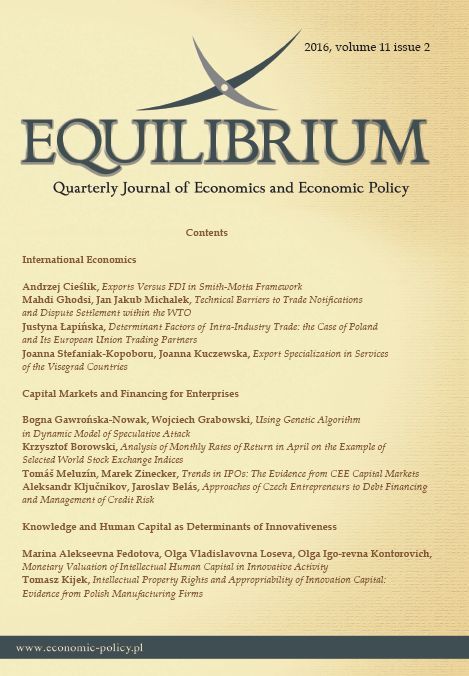Using genetic algorithm in dynamic model of speculative attack
DOI:
https://doi.org/10.12775/EQUIL.2016.013Keywords:
currency crisis, dynamic model, genetic algorithmsAbstract
Evolution of speculative attack models shows certain progress in developing the idea of the role of expectations in the crisis mechanism. Obstfeld (1996) defines expectations as fully exogenous. Morris and Shin (1998) treat the expectations as endogenous (with respect to noise), not devoting too much attention to information structure of the foreign exchange market. Dynamic approach proposed by Angeletos, Hellwig and Pavan (2006) offers more sophisticated assumption about learning process. It tries to reflect time-variant and complex nature of information. However, this model ignores many important details like a Central Bank cost function. Genetic algorithm allows to avoid problems connected with incorporating information and expectations into agent decision-making process to an extent. There are some similarities between the evolution in Nature and currency market performance. In our paper an assumption about rational agent behaviour in the efficient market is criticised and we present our version of the dynamic model of a speculative attack, in which we use a genetic algorithm (GA) to define decision-making process of the currency market agents. The results of our simulation seem to be in line with the theory and intuition. An advantage of our model is that it reflects reality in a quite complex way, i.e. level of noise changes in time (decreasing), there are different states of fundamentals (with ?more sensitive? upper part of the scale), the number of inflowing agents can be low or high (due to different globalization phases, different capital flow phases, different uncertainty levels).
Downloads
References
Arifovic, J., & Maschek, M. K. (2012). Currency crisis: Evolution of beliefs and policy experiments. Journal of Economic Behavior & Organization, 82(1). DOI:10.1016/j.jebo.2012.01.001.
Aydin, A. D., and Cavdar, S. C. (2015). Prediction of Financial Crisis with Artificial Neural Network: An Empirical Analysis on Turkey. International Journal of Financial Research, 6(4). DOI: 10.5430/ijfr.v6n4p36.
De Grauwe, P., & Grimaldi, M. (2006). The Exchange Rate in a Behavioral Finance Framework. Princeton University Press.
Fama, E. F. (1970). Efficient Capital Markets: A Review of Theory and Empirical Work. Journal of Finance, 25(2).
Frydman, R., & Goldberg, M. D. (2007). Imperfect Knowledge Economics: Exchange Rates and Risk. Princeton University Press.
Lyons, R. K. (2001). The Microstructure Approach to Exchange Rates. Cambridge: MA: MIT press.
Morris, S., & Shin, H. S. (1998). Unique Equilibrium in a Model of Selffulfilling Currency Attacks. American Economic Review, 88(3).
Sarlin, P. (2014). On Biologically Inspired Predictions of the Global Financial Crisis. Neural Computing and Applications, 24(3-4).
Sarno, L., & Taylor, M. P. (2002). The Economics of Exchange Rates. Cambridge: Cambridge University Press.
Tversky, A., & Kahneman, D. (1991). Loss Aversion in Riskless Choice: A Reference-dependent Model. Quarterly Journal of Economics, 106(4).






